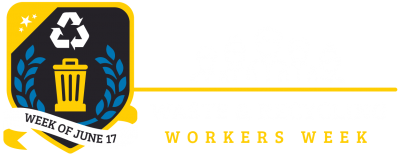
Mr. Squirrel wants to say “Happy Earth Day!”
Waste and Recycling Workers Week supports Earth Day!
Let’s do our part and contribute to the global effort to make our world more sustainable. We believe that our children and the generations to come deserve to live in a healthy world.
Environmentally friendly
To help you get started, check out The Recycle Guide, a free resource packed with information to help you start preserving the Earth today!
Here’s a bit of what you will learn from The Recycle Guide:
What to Recycle
Did you know that not everything can be recycled? We wish everything could be recycled, but that’s not the case. And some materials are recyclable, but may not be accepted for recycling in your area. That’s why it’s important to learn the basics of recycling rules and etiquette.
Recycling right is important. Number reports site contamination rates at recycling facilities have increased significantly over the past few years due to what some call “aspirational recyclers.” When non-recyclable materials end up in your recycling bin, it can slow the recycling process and frequently requires recycling plants to stop the waste processing line and clean out equipment by hand.
Plus, when you know what can go in the recycling bin, you can become a more environmentally conscious shopper by limiting your non-recyclable purchases. So not only will you increase your recycling, you will reduce your waste.
Why Recycling Matters
Globally, the average person produces 2.6 pounds of garbage every day. In America, we generate a whopping 4.4 pounds of trash per person per day. That’s over 1,600 pounds per year. As a country, that’s 254 million tons per year. That’s enough waste to reach the moon and back 25 times.
Those numbers really add up quick. The good news is the average American recycles or composts about 1.5 pounds of that daily waste. With only 34% of Americans recycling, there is a lot we can do to improve these numbers and decrease waste. Countries like Germany and Austria are recycling twice as much of their daily waste while other countries produce substantially less waste per capita.
With so much room for improvement, it’s shockingly easy to have an impact. If more people recycle, we can increase amount of waste diverted and decrease the need for new resources. If you already recycle, take this opportunity to brush up on your recycling. Know what can and can’t be recycled and adjust your shopping habits to decrease the amount of non-recyclable materials you purchase.
Not convinced yet? Here are some more facts and statistics to show you just how much recycling matters.
Where Can You Recycle
Landfills, dumps and sorting facilities, oh my! If you’re not savvy to waste industry lingo, you may think these facilities are all the same. You would be wrong. There are many types of waste processing facilities and they all handle waste disposal differently. This means the amenities offered at each facilities can vary dramatically.
The easiest way to find out what your options are is to check with your local municipal government or commercial waste management company to see if recyclable materials can be picked up from your home. If that’s not an option, they should be able to direct you to the nearest facility that processes recyclable materials. The Recycle Guide also connects to easy to use resources to help you find the closest facility. You can also find some services to recycle by mail for specific materials like cell phone batteries and ink cartridges.
Free Learning Resources
If you’re a teacher looking for resources to help your students or a parent trying to teach your kids about recycling, The Recycle Guide has lots of free resources. How to Recycle, Recycling in Schools, and Recycling Activities are great places to start.
Find more information about recycling and the role your garbage workers play in the process at The Recycle Guide and Waste and Recycling Workers Week!
Connect with The Recycle Guide on Facebook to share ideas and learn from others working to preserve our Earth.

